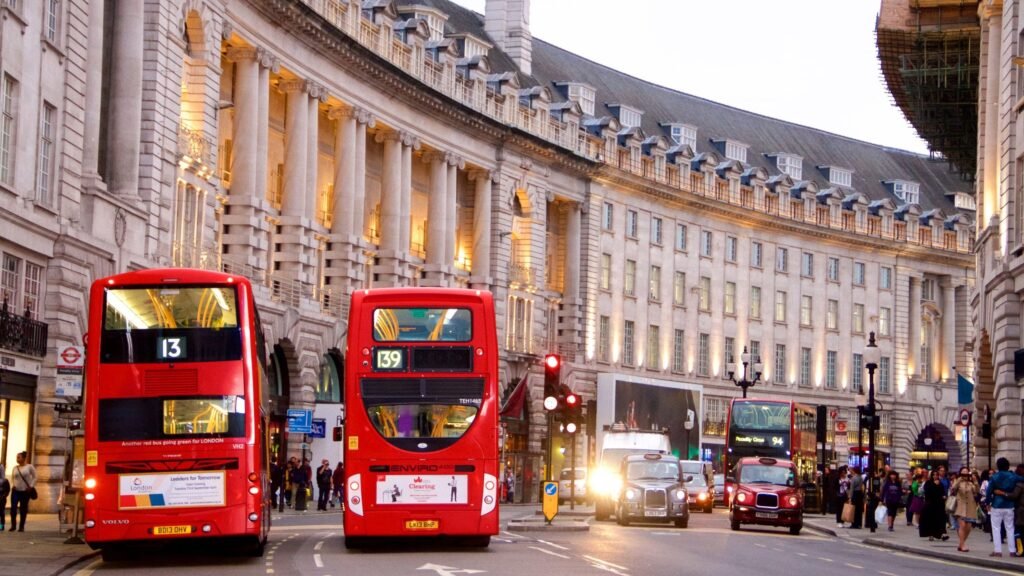This post may contain affiliate links which means we may receive a commission at no cost to you, if you make a purchase through a link. Please see our full disclosure for further information.
London isn’t just a city—it’s a tapestry woven from rivers, centuries of stories, and pockets of refined living that feel both timeless and vibrant. To truly get to know it, you need to dig into the details that make it unique: the river that shapes its layout, the history etched into every street, the neighborhoods where luxury lives quietly, and the clubs that have long been hubs of elite social life. That’s exactly what London: Exploring Its Geography, History and Luxury Spots invites you to do—uncover the layers that turn a visit or stay here into something unforgettable.
The Geography: A River That Binds London Together
London’s geography isn’t just about maps—it’s about how the city grows and breathes, and the Thames River is at the center of it all. This 215-mile waterway cuts through the heart of London, splitting it into north and south, and has been its lifeline for over 2,000 years.
In Roman times, it brought trade ships loaded with goods; during the Industrial Revolution, it powered mills and factories; today, it’s lined with landmarks—Tower Bridge, the London Eye, the Shard—that offer postcard-perfect views and a sense of scale to the city.
Beyond the Thames, London breaks down into distinct areas, each with its own personality:
- The City of London (The Square Mile): This tiny, historic core is where London’s financial power lies. Think the Bank of England, the London Stock Exchange, and a mix of modern skyscrapers (like The Gherkin) and 17th-century churches—all packed into just one square mile. It’s busy by day with bankers and professionals, but quietens down at night, a contrast that feels uniquely London.
- Inner London: This is where the city’s energy and luxury cluster. Neighborhoods like Westminster (home to Buckingham Palace and Parliament), Kensington, and Chelsea sit here, close to major landmarks, cultural spots (museums, theaters), and high-end shops. The Tube (London’s underground) makes it easy to zip between areas, but wandering the streets—with their mix of old and new buildings—feels like exploring a living museum.
- Outer London: For those who want space and greenery, outer areas like Richmond and Hampstead deliver. Richmond has one of London’s largest Royal Parks (Richmond Park, where you can spot deer), while Hampstead Heath offers sweeping views of the city skyline. These spots feel more like suburbs than a big city, but still connect to the center in under 30 minutes via public transport.
London’s green spaces are another key part of its geography—Hyde Park, Kensington Gardens, and Regent’s Park break up the concrete, giving residents and visitors a chance to escape the bustle. It’s this balance of urban energy and natural calm that makes London’s geography so appealing, especially for those seeking luxury that doesn’t feel cramped.
The History: Stories in Every Cobblestone
London’s luxury spots don’t exist in a vacuum—they’re rooted in a history that stretches back over two millennia, each era leaving its mark on the city. To walk through its streets is to step through time, and that sense of heritage is what makes its refined living feel so meaningful.
- Roman Londinium (43 AD): The Romans founded London as a trading post on the Thames, building walls (parts of which still stand near the Tower of London) and roads that laid the groundwork for the city’s layout. Even today, street names like “Cheapside” (from the Old English word for “market”) hint at its Roman-era role as a commercial hub.
- Medieval London (11th–15th Centuries): After the Norman Conquest in 1066, William the Conqueror built the Tower of London to secure his power—a structure that would go on to serve as a palace, prison, and treasure vault (it still holds the Crown Jewels). This era also saw the rise of guilds in the City of London, setting the stage for its future as a financial center.
- Tudor & Stuart London (16th–17th Centuries): This was a time of grandeur and upheaval. Henry VIII built Hampton Court Palace, a short drive from the city, while the Great Fire of London in 1666 destroyed much of the medieval center—only to be rebuilt with wider streets and sturdier stone buildings, including Sir Christopher Wren’s iconic St. Paul’s Cathedral.
- Victorian London (19th Century): The Industrial Revolution turned London into a global powerhouse, and the Victorian era brought luxury to the elite. Grand townhouses sprung up in Kensington and Belgravia, Harrods opened its doors in 1849, and the first Tube line launched in 1863—making it easier for wealthy families to commute to the city center.
- Modern London (20th–21st Centuries): World War II bombings damaged parts of the city, but post-war reconstruction brought new life: the brutalist Barbican Centre, the sleek Shard, and a renewed focus on preserving historic sites while embracing innovation. Today, you’ll find 17th-century pubs next to Michelin-starred restaurants, and Georgian townhouses beside glass skyscrapers—proof that London honors its past while moving forward.
This history isn’t just for tourists. Living in a Belgravia townhouse or dining in a St. James’s club means being surrounded by stories—of kings, artists, and visionaries—and that connection to the past is a big part of what makes London’s luxury feel so special.
Luxury Neighborhoods: Where Refined Living Calls Home
London’s luxury neighborhoods aren’t just expensive—they’re places with distinct characters, where every street, shop, and garden feels curated. These are the spots where royals, celebrities, and business leaders choose to live, drawn by privacy, convenience, and a sense of belonging.
1. Kensington
Kensington is the epitome of classic London luxury. It’s home to Kensington Palace (where Prince William and Kate Middleton live), and its streets are lined with grand Victorian and Georgian townhouses—many with private gardens and staff quarters. The area is also a cultural hub: the Victoria and Albert Museum (home to art and design treasures), the Natural History Museum, and the Science Museum are all here.
Kensington High Street has high-end boutiques (think Gucci, Prada) and gourmet cafes, while Kensington Gardens offers a quiet escape with its lakes and tree-lined paths. It’s a neighborhood where elegance feels effortless, perfect for those who want to be close to both royalty and culture.
2. Belgravia
If Kensington is classic, Belgravia is exclusive—one of the most expensive neighborhoods in the world. Tucked between Buckingham Palace and Knightsbridge, it’s filled with white stucco townhouses, narrow mews lanes (once home to coach houses, now converted into luxury homes), and embassies. The streets are quiet, with little traffic, and many properties have hidden gardens that offer total privacy.
Belgravia rarely has homes for sale, but when it does, they fetch tens of millions of pounds—attracting billionaires, royals, and A-list celebrities who value discretion above all. Even the local shops are upscale: think bespoke tailors, luxury grocers, and art galleries that don’t advertise their wares to passersby.
3. Chelsea
Chelsea has a more relaxed, artistic vibe than Kensington or Belgravia—but it’s no less luxurious. Its main street, the King’s Road, was made famous in the 1960s by the “Swinging Sixties” scene, and today it’s lined with designer boutiques, independent art galleries, and gourmet delis.
The residential streets are filled with colorful townhouses (many with blue plaques marking famous former residents, like Oscar Wilde) and the Chelsea Physic Garden—founded in 1673, it’s one of London’s oldest botanical gardens. Chelsea is popular with creative professionals and families: it has great schools, quiet parks, and a community feel that makes it feel like a village within the city.
4. St. John’s Wood
For those who want luxury with space, St. John’s Wood is ideal. This leafy North London neighborhood is known for its large detached homes (many with big gardens), and it’s a short walk from Regent’s Park—one of London’s most beautiful Royal Parks. It’s also home to two iconic spots: Abbey Road Studios (where The Beatles recorded most of their music) and Lord’s Cricket Ground (the “home of cricket”).
St. John’s Wood has a laid-back vibe: local cafes are filled with families, and the high street has a mix of upscale shops and independent businesses. The Tube gets you to Oxford Street in 10 minutes, so you’re never far from the city’s action—but you can leave the bustle behind when you get home.
Luxury Clubs: Elite Spaces for Connection and Privacy
London’s private clubs are more than just places to eat or drink—they’re institutions, woven into the city’s luxury fabric for centuries. Most are invitation-only, with strict membership rules, and they offer a level of privacy and exclusivity that’s hard to find elsewhere. For London’s elite, they’re where business is done, friendships are forged, and quiet moments of relaxation happen away from the public eye.
1. White’s
Founded in 1693, White’s is London’s oldest and most traditional gentlemen’s club. Tucked away on St. James’s Street (a street known for its historic clubs), it has dark wood paneling, leather armchairs, and a bar that serves classic cocktails like martinis and old fashioneds.
The dress code is strict—no jeans, no sneakers, no casual wear—and the atmosphere feels like stepping back in time. White’s has counted kings, prime ministers, and aristocrats among its members, and it’s still a place where old-world etiquette and discretion matter most. It’s not for everyone, but for those who value tradition, it’s the gold standard.
2. Annabel’s
Annabel’s, founded in 1963, is a more modern take on luxury. Located in Berkeley Square, it’s a private members’ club that blends 1960s glamour with contemporary opulence: think velvet sofas, crystal chandeliers, and walls lined with art. Unlike White’s, it welcomes both men and women, and its menu features gourmet dishes from around the world (plus a killer afternoon tea).
Annabel’s is known for its exclusivity—membership is by invitation only, and waitlists can stretch for years—and its commitment to privacy. Celebrities and business leaders love it because they can dine, dance, or relax without worrying about paparazzi or unwanted attention. Its rooftop garden, with views of Berkeley Square, is a favorite spot for summer events.
3. The Arts Club
For those who love culture as much as luxury, The Arts Club is the perfect fit. Founded in 1863, it’s a members’ club in Mayfair that caters to artists, writers, musicians, and anyone with a passion for the creative arts. Inside, you’ll find art exhibitions (often featuring up-and-coming artists), live music nights, and panel discussions with industry leaders—alongside bars and restaurants that serve delicious, unpretentious food.
The decor is a mix of classic and modern: original artworks hang on the walls, and the furniture feels comfortable, not stuffy. It’s a place where you might sit next to a famous actor at the bar, or chat with a gallery owner over lunch—all in a space that feels relaxed and welcoming.
4. Brooks’s
Another historic gentlemen’s club (founded in 1764), Brooks’s is known for its political connections. Many British prime ministers have been members, and it’s a popular spot for quiet debates and networking. The clubhouse has a grand dining room, a cozy library filled with rare books, and a courtyard garden where members can sit and chat in the summer.
Brooks’s is famous for its “Betting Book,” a leather-bound volume where members have placed wagers on everything from horse races to political elections since the 18th century. Like White’s, it’s steeped in tradition, but it has a warmer, more convivial atmosphere—making it a favorite among those who want to mix business with pleasure.
Why London’s Luxury Feels One of a Kind
What makes exploring London’s geography, history, and luxury spots so special? It’s the way these elements blend seamlessly. The Thames doesn’t just divide the city—it adds a sense of grandeur that makes even its most exclusive neighborhoods feel connected to something bigger. Its history isn’t just in museums—it’s in the walls of Belgravia’s townhouses and the wood paneling of White’s. And its luxury isn’t about showing off—it’s about privacy, heritage, and a way of life that’s been polished over centuries.
Whether you’re strolling through Kensington Gardens at sunset, dining in a historic club, or wandering the cobblestones of the City of London, you’re experiencing a city that knows how to honor its past while embracing the present. London’s luxury isn’t flashy; it’s thoughtful, and it’s meant to be savored. That’s the magic of London: Exploring Its Geography, History and Luxury Spots—it’s not just about places, but about the feeling of being part of something timeless.
Uncover further inspiration in our blog.
The UK’s Most Prestigious Horse Racing Events
The 5 Most Prestigious UK Horse Racing Events
What Are The Best Racecourses to Visit in the UK?















